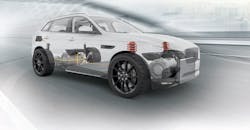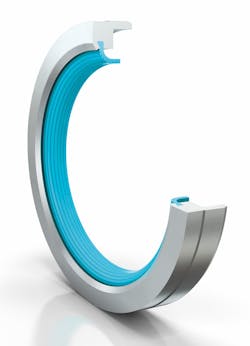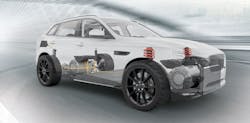New Seals Reduce Friction for Electric Vehicle Adoption
Since Hungarian Ányos Jedlik invented the first electric car in 1828, the automotive industry has increasingly pursued the dream of a world transported by electrically powered vehicles. Although the sale of electric cars is growing, mass adoption remains a pipe dream. And it will remain so until electric cars deliver the same mileage per battery charge as a tank of gasoline.
The pressure is on to find a solution, as the quest for ever-lower CO2 emissions increases and the desire to retain vehicle access in some of the world’s most-populous cities becomes paramount. Electrically driven vehicles, therefore, need to become the norm rather than a novelty.
According to a report by the International Energy Agency (IEA), 3.1 million electric vehicles travelled the roads globally in 2017. However, this is expected to grow exponentially with estimates ranging from 125 to 220 million electric cars worldwide by 2030.
One key to this growth is the availability of components that enable electric vehicles to operate more like conventional vehicles, providing drivers the independence and reliability they expect. Unfortunately, electric vehicles tend to have shorter traveling ranges than gasoline and diesel vehicles. Additionally, battery charging takes a lot longer than filling up with traditional fuel, and the charging infrastructure is not yet widely available. These shortcomings lead to range anxiety¾the fear that a vehicle has insufficient range to reach its destination¾stranding the vehicle and its occupants. The solution to this is to build the charging infrastructure, improve charging efficiency, and increase battery capacity to extend the distance that cars can travel on a single charge.
The HiSpin HS40's hydrodynamic feature helps reduce frictional torque, while oil back-pumping leads to improved sealing performance without causing any shaft damage.
In electric vehicles, the e-axle is a critical component that performs the function of an engine and transmission combined. It is an electro-mechanical propulsion system contained in an axle structure that houses an electric motor, power electronics, and some form of gearing/differential. All of these fit within the traditional engine space. The motor and gearbox are directly coupled, and while the gearbox requires efficient lubrication, it is essential that the motor remain dry. To facilitate this, a highly reliable seal is required between these two components.
The difficulty in sealing this system is that electric motors run most efficiently at high speeds. Gasoline engines normally run at 2,000 to 4,000 revolutions per minute (RPM). The electrically-driven transmission runs up to eight times faster, typically at 16,000 RPM. In the future, this is likely to increase significantly.
The rotational speed limit for traditional seals in today’s e-axle is around 100 feet per second. However, to maximize efficiency, the theoretical optimal rotational surface speed of the e-axle would be greater than 200 feet per second¾a speed that is currently impossible to achieve.
This limits electric cars to traveling short distances. But since most electric cars are generally small and used for short journeys in urban areas, it’s acceptable for the electric drive unit to operate at a relatively low speed. However, if electric cars are going to challenge combustion-driven vehicles, they will need to be capable of traveling 250 to 300 miles on a single charge (the equivalent of gasoline-powered vehicles) rather than the 175-mile average achieved today. The challenge facing e-Mobility seal manufacturers is increasing operating rotational speed to support electric vehicle manufacturers’ mission to extend traveling distance from one charge to the next.
Developments are now seeing specialized sealing solutions meet the requirements to support the evolving electric vehicle sector, often exceeding electric vehicle manufacturers' target speed of at least 130 feet per second. Some seals perform comparably relative to critical torque and power consumption and exhibit zero leakage, despite the highly demanding sealing conditions. In one case, a seal reduced friction 75% compared to a standard seal of its type. And it proved capable of operating at 200 feet per second.
Trelleborg's engineering innovations are working to extend drive time in electric vehicles.
Test results for these specialized seals meet key parameters with test procedures that take into consideration requirements of the electric vehicle manufacturers, reviews of multiple sets of application data, and discussions with major automatic transmission fluid (ATF) and bearing manufacturers. Tests were performed on a 38 millimeter shaft at rotation speeds of up to 21,000 RPM (130 feet per second) in temperatures ranging from −40°F to +302°F in ATF oil mist conditions for a duration of a 500-hour accelerated load cycle test. This represented real driving conditions, including reversing, city driving, stopping and starting in traffic jam, and high-speed highway driving. In addition to the 500-hour accelerated load cycle test, seals were subjected to more than 3,000 hours of endurance testing.
The newly developed seals passed the accelerated load cycle test with no leakage and no wear on the sealing lip or shaft. In fact, the wear on the running surface was barely noticeable and Finite Element Analysis (FEA) results all proved positive. The one seal utilizes polytetrafluoroethylene (PTFE) based material ensures compatibility with virtually all media. A second design is in proprietary low temperature FKM fluoroelastomer. To meet electric vehicle manufacturing needs required fluid compatibility testing—specifically, long-term immersion in ATF commonly used in electric drive systems for 168 hours at +284°F and 500 and 1,000 hours at +257 °F. Compared to terpolymer FKM, ethylene acrylic rubber (AEM), and acrylic rubber (ACM) materials, the FKM elastomer demonstrated significantly less volume change and excellent retention of chemical and mechanical properties.
These seals are undergoing extended testing by several electric systems and vehicle manufacturers. Provided the seals continue to perform as expected, they could noticeably extend the distance traveled by electric vehicles between charges. And that will likely lead to a lot more electric vehicles on the road.
Harlan Hart is technical manager, e-Mobility for Trelleborg Sealing Solutions.



